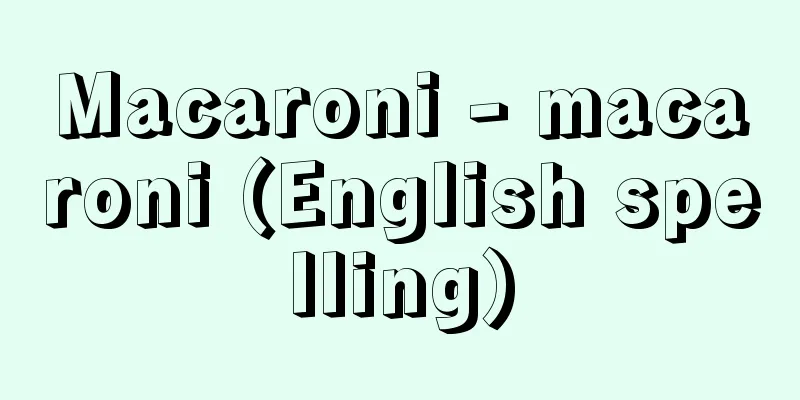The Oei War

|
In 1399 (Oei 6), the powerful shugo Ouchi Yoshihiro started a rebellion against the Muromachi Shogunate. Yoshihiro's achievements, such as suppressing Kyushu, putting down the Meitoku Rebellion (1391), and mediating the unification of the Northern and Southern Courts, led him to become the shugo of Iwami, Buzen, Izumi, and Kii in addition to Suo and Nagato under his father Hiroyo, and he boasted of his wealth and power through trade with Korea. Meanwhile, Shogun Ashikaga Yoshimitsu, who succeeded in unifying the Southern Courts, was seeking an opportunity to suppress and force submission on the powerful shugo in order to stabilize and absolute the power of the shogunate. For Yoshimitsu, Yoshihiro's tendency to monopolize trade with Korea and his strong interference in trade with Ming China, which was closely linked to the shogunate's unification of Kyushu, reminded him of Imagawa Ryoshun, the Kyushu tandai (chief of the Kyushu shogunate) whom he had dismissed earlier, and he decided to subjugate Yoshihiro. Since Shibukawa Mitsuyori was appointed Kyushu tandai in 1396, Kyushu had been in turmoil, and Yoshimitsu took Yoshihiro's visit to Kyushu as an opportunity to begin provoking him. In response, Yoshihiro allied with Ashikaga Mitsukane, the Kamakura kubo (bō) who was in conflict with Yoshimitsu at the time, and in October 1399, he landed in Sakai (Sakai City, Osaka Prefecture) in his domain of Izumi, criticized Yoshimitsu's politics, and presented Mitsukane's imperial edict, making clear his intention to subjugate Yoshihiro. Yoshimitsu sent out a large army of tens of thousands at the beginning of November, so Yoshihiro set up many well towers and turrets in Sakai and barricaded himself there. On the 29th of the same month, the two armies fought but no decision was made. Around the same time, Mitsukane called on the various provinces to rise up in revolt against the shogunate and intended to march to Kyoto himself, but failed to do so. Meanwhile, in Sakai, Yoshihiro was killed in battle in a full-scale attack by the shogunate forces on December 21, and his younger brother Hiromochi surrendered. As a result, the eastern provinces and Kamakura returned to peace in March of the following year, 1400, and Yoshimitsu, as a measure to deal with the rebellion, confiscated Izumi, Iwami, Kii, and Buzen from the Ouchi clan and granted Hiromochi the right to control Suo and Nagato. However, Yoshihiro's younger brother Moriharu, who had been put in charge of Yoshihiro's affairs, refused to allow Hiroshige to enter the country and in 1301 defeated and killed Hiroshige, thus reducing his power, so the shogunate made peace with Morimi and appointed him as the Shugo of Suo and Nagato. Yoshimitsu's reduction of the power of the Ouchi clan was thus achieved, which led to the heyday of the Muromachi shogunate. However, the fact that the shogunate was forced to take insufficient measures in the aftermath of the Oei War ultimately had a major impact on the shogunate's control over the Shugo daimyo. [Masaki Kubota] "Sato Shinichi, 'The Turmoil of the Northern and Southern Courts' ('Japanese History 9', 1965, Chuokoron-Shinsha)" ▽ "Matsuoka Hisato, 'Ouchi Yoshihiro' (1966, Jinbutsu Oraisha)" Source: Shogakukan Encyclopedia Nipponica About Encyclopedia Nipponica Information | Legend |
|
1399年(応永6)有力守護大内義弘(おおうちよしひろ)が室町幕府に対して起こした反乱。義弘は九州鎮圧や明徳(めいとく)の乱(1391)の平定および南北朝合体の斡旋(あっせん)などの功によって、父弘世(ひろよ)時代の周防(すおう)、長門(ながと)に加え、石見(いわみ)、豊前(ぶぜん)、和泉(いずみ)、紀伊(きい)の守護となり、さらに対朝鮮貿易により富強を誇っていた。一方、南朝合体に成功した将軍足利義満(あしかがよしみつ)は幕府権力の安定・絶対化を図るため、有力守護への抑圧と服従を強要しようとし、その機会をねらっていた。このような義満にとって、義弘による対朝鮮貿易の独占的傾向と、幕府の九州統一と密接する対明(みん)貿易への強い干渉は、先に解任した九州探題今川了俊(りょうしゅん)を想起させ、義弘討伐を決意させるに至った。1396年の渋川満頼(みつより)の九州探題就任以降、九州では動乱が生じており、義満は、義弘が九州へ赴いたのを好機として挑発を開始した。これに対し義弘は、当時義満と対立していた鎌倉公方(くぼう)足利満兼(みつかね)と結び対抗、99年10月、領国和泉の堺(さかい)(大阪府堺市)に上陸し、義満の政治を批判、満兼の御教書(みぎょうしょ)を奉じ討伐の意志を明らかにした。義満は11月の初めに数万の大軍を発向(はっこう)させたため、義弘は堺に多くの井楼(せいろう)や櫓(やぐら)を設け籠城(ろうじょう)。同月29日両軍は戦闘に及んだが勝敗は決しなかった。これと前後して満兼は諸国に反幕府の挙兵を呼びかけ、自ら上洛(じょうらく)を意図したが果たせなかった。一方、堺では12月21日に幕府軍の総攻撃により義弘は戦死し、弟の弘茂(ひろもち)は降服した。この結果、翌1400年3月には東国、鎌倉も鎮静に帰し、義満は乱後の処置として、大内氏より和泉、石見、紀伊、豊前を没収し、弘茂に周防、長門を安堵(あんど)した。しかし、義弘に後事を任されていた別弟の盛見(もりはる)は、弘茂の入国を拒否し、01年には弘茂を敗死させるなどその勢力を圧したため、幕府は盛見と和し、周防、長門の守護に任じた。こうして義満の大内氏勢力削減は達成され、この後、室町幕府の全盛期を創出するに至った。しかし、応永の乱の事後処理に幕府が不十分な措置をとらざるをえなかったことは、最終的に幕府による守護大名の統制に大きな影響を及ぼすことになった。 [久保田昌希] 『佐藤進一著『南北朝の動乱』(『日本の歴史 9』1965・中央公論社)』▽『松岡久人著『大内義弘』(1966・人物往来社)』 出典 小学館 日本大百科全書(ニッポニカ)日本大百科全書(ニッポニカ)について 情報 | 凡例 |
Recommend
Luke (English spelling) Loukās (Greek)
The writer of the Gospel of Luke and the Acts of ...
Karasawa Cirque - Karasawa Cirque
... The mountain is mainly composed of hard rock ...
Nogodinidae
…As their elegant name suggests, this group of he...
Black Sea (English spelling) Чёрное Море/Chyornoe More Russian
An inland sea between Europe and Asia. It is bord...
Plum blossoms in spring
Kiyomoto. A gift. Words by Yomonomakado (= Lord of...
Harvesting and reaping - Kariwakekosaku
A method of farming in which the landlord and tena...
Golden fence - Ogonbae
…At the tip of the peninsula, overlooking the Bun...
Organelle
…It is sometimes simply called a cell organelle o...
Inu no Mansui - Inu no Mansui
...With the opening of the port, silkworm eggs an...
Flag Pavilion
〘 noun 〙 (From the Chinese custom of erecting flag...
Rockefeller, NA (English spelling) RockefellerNA
...The current head of the Rockefeller family is ...
Interval - Ontei (English spelling) interval English
This refers to the difference in pitch between tw...
Ontade - Ontade
A perennial plant of the Polygonaceae family (APG...
Retroverted uterus
A type of uterine abnormality. Normally, the body ...
Cardoso, M.
…The main composers of the 16th century were the ...









